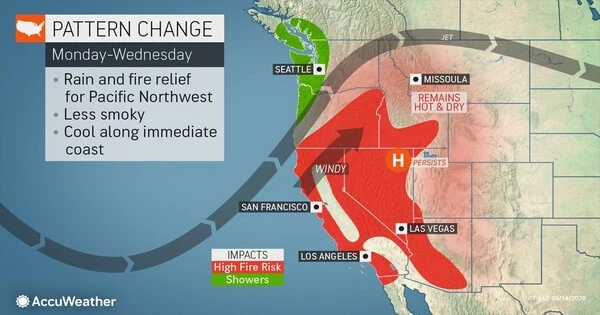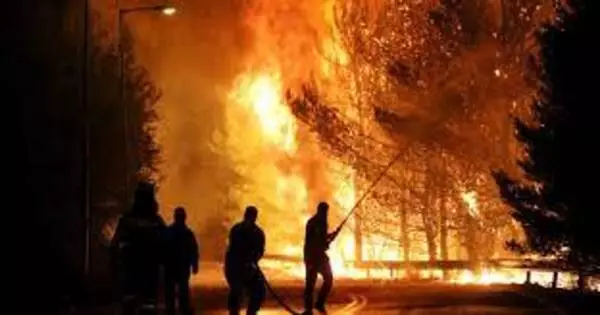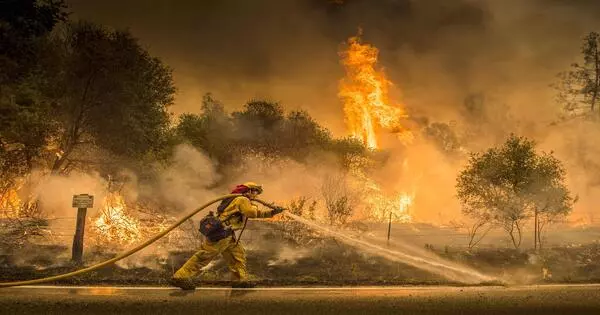According to new research, increasingly large and intense wildfires in the Pacific Northwest are changing the seasonal rhythm of air pollution and producing a rise in hazardous pollutants in August. According to the study, smoke is eroding clean air gains and creating possible health concerns for millions of people.
The study, coordinated by scientists at the National Center for Atmospheric Research (NCAR), discovered that carbon monoxide levels—a chemical that indicates the presence of other air pollutants—increased substantially in August as wildfires spread. Carbon monoxide levels are generally lower in the summer due to chemical reactions in the atmosphere caused by variations in sunshine, and the discovery that they have risen demonstrates the intensity of the smoke’s effects.
Lead author and NCAR scientist Rebecca Buchholz said that “wildfire emissions have increased so significantly that they are affecting the annual pattern of air quality across North America.” “It’s evident that there’s a new peak of air pollution in August that didn’t exist before.”

Although carbon monoxide is not a major health risk in the open air, it does suggest the presence of more dangerous pollutants such as aerosols (airborne particles) and ground-level ozone, which tends to accumulate on hot summer days.
The researchers tracked wildfire emissions over the previous two decades using satellite-based observations of atmospheric chemistry and global fire inventories, as well as computer modeling to assess the possible implications of the smoke. They concentrated on three regions of North America: the Pacific Northwest, the central United States, and the Northeast.
The findings, according to Buchholz, were particularly startling because carbon monoxide levels have been reduced elsewhere, both globally and in North America, thanks to advancements in pollution-control systems.
Impacts from air pollution are becoming more severe.
Due to a mix of climate change, rising development, and land use restrictions, wildfires have been on the rise in the Pacific Northwest and other parts of North America. Fires are becoming a more significant source of air pollution, especially as emissions from human activities decrease due to more efficient combustion processes in automobiles and industrial operations.

Buchholz and her colleagues used data from two NASA Terra satellite instruments to analyze the effects of fires: MOPITT (Measurements of Pollution in the Troposphere), which has tracked carbon monoxide continuously since 2002, and MODIS (Moderate Resolution Imaging Spectrometer), which detects fires and provides information on aerosols. They also looked at four wildfire emissions inventories that rely on MODIS data.
The researchers concentrated on the period from 2002, when a continuous and long-term record of MOPPIT data began, through 2018, the final year for which complete observations were available at the time they began their research.
The findings revealed an increase in carbon monoxide levels across North America in August, which coincided with the Pacific Northwest’s peak burning season. According to the emissions inventories, the shift was most noticeable from 2012 to 2018, when the Pacific Northwest fire season became substantially more active. Data from the MODIS instrument found that aerosols increased in August as well.
The scientists removed other potential emission sources to ascertain whether the elevated pollution levels were caused by the fires. They discovered that carbon monoxide levels upwind of the Pacific Northwest, over the Pacific Ocean, were significantly lower in August, indicating that pollution was not blowing in from Asia. They also discovered that the fire season in the central United States and the Northeast did not correlate with the August rise in pollution, implying that local fires in those areas were not to blame. Furthermore, they examined a pair of fossil fuel emission inventories, which revealed that human-caused carbon monoxide emissions did not increase in any of the three study zones from 2012 to 2018.
Multiple lines of evidence point to worsening wildfires in the Pacific Northwest as the source of poor air quality, Buchholz explained. “It’s especially sad that these fires are hurting society’s overall accomplishments in decreasing pollution.”
Human Health Dangers
The findings have consequences for human health because wildfire smoke has been connected to substantial respiratory difficulties, as well as affecting the cardiovascular system and negatively impacting pregnancy outcomes.
Buchholz and her colleagues utilized an NCAR-based computer model, the Community Atmosphere Model with a chemistry component, to predict the movement of emissions from Pacific Northwest wildfires and their impact on carbon monoxide, ozone, and fine particulate matter. The simulations were carried out on the NCAR-Wyoming Supercomputing Center’s Cheyenne supercomputer. According to the findings, the pollutants might affect over 130 million people, including approximately 34 million in the Pacific Northwest, 23 million in the Central United States, and 72 million in the Northeast.
Although the study did not go into detail on the health effects of the emissions, the scientists looked at respiratory fatality rates in Colorado from 2002 to 2011, comparing them to the same month from 2012 to 2018. They chose Colorado, which is located in the study’s central United States region, since respiratory fatality rates in the state were easily accessible.
They discovered that Colorado respiratory fatalities in August increased considerably between 2012 and 2018, while fires in the Pacific Northwest caused greater pollution in August but not in Colorado.
It’s evident that more research into the health ramifications of all this smoke is required, Buchholz added. “We may already be seeing the effects of these flames on the health of residents hundreds, if not thousands, of miles away.”





